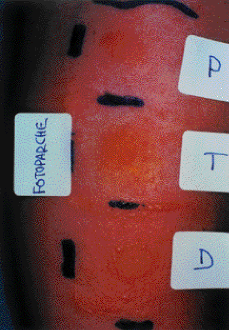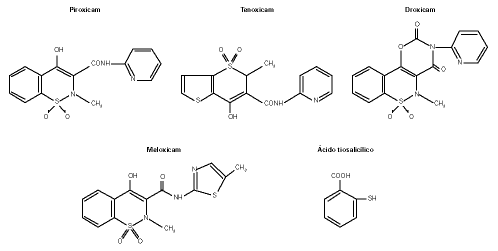INTRODUCTION
Oxicams are nonsteroidal antiinflammatory drugs widely used in reumathologic diseases treatment. Among the different drugs of this family available in our country, piroxicam is the most frequently used. 1-3 % of patients taking this drug develop cutaneous adverse reactions, the second most frequent after the gastrointestinal ones. Photosensitivity and dyshidrotic eczema are the most typical piroxicam-induced cutaneous reactions (1).
Thimerosal, synthesized from ethylmercuric chloride and thiosalicylic acid, is a preservative used mainly in vaccines, ear, eye and nose drops, and as a topical antiseptic. Allergy to thimerosal is due either to the mercurial moiety, to thiosalicylic acid or to both.
According to different studies, between 75 and 83 % of patients with contact allergy to thimerosal, thiosalicylic acid sensitized, can develop photodermatitis to piroxicam (2-5). A photoproduct of piroxicam, with chemical similarity to thiosalicylic acid, could be responsible for the cross-reaction with this molecule (3, 6).
Photosensitivity reactions with other oxicams are uncommon, although a case of droxicam-induced photodermatitis, with positive photopatch test to piroxicam, has been reported (7). Therefore, in patients with a history of piroxicam-induced photoallergy, tenoxicam may be used safely because it does not cross-react with piroxicam (3, 7).
We report a case of piroxicam-induced photodermatitis and dermatitis in a patient with contact allergy to thimerosal, tiosalicylic acid sensitized, in which we have investigate cross-reactivity among different oxicams.
CASE REPORT
A 44-year-old man with contact allergy to thimerosal. A few hours after the intake of Feldene (piroxicam) while running outside, developed a papuloerithematosus exanthema in the neck, knees and forearms, and microvesicles on the finger webs, that became descamative a few days later. Previously, he had developed a similar incident, outdoors, a few hours after the oral intake of Feldene and local use of Sasulen (topical piroxicam).
Allergologic study
Patch tests with thiosalicylic acid (0.1 % pet.) and mercury (1 % pet.), with readings at 48 and 96 hours, were performed. Duplicate patch tests with piroxicam (0.1 %, 1 % pet.) and (1 % in dimethyl-sulfoxide [DMSO]), droxicam (1 % pet.), tenoxicam (1 %, 10 % pet.) and meloxicam (1 % pet.) and (1 % DMSO) were applied. Tests were removed after 48 hours and then, while one set of tests was protected from light, the other was irradiated with 5.0 J/cm2 of UVA light. Readings were made just before irradiation and 48 hours thereafter. Control patch test with DMSO was included. Only (+ +) or more reactions were considered positive.
The study was also performed in a group control of ten healthy subjects without history of contact allergy.
RESULTS
Patch tests with thiosalicylic acid (0.1 % pet.) was positive and negative with mercury. Among the oclusive patch tests, only piroxicam (1 % DMSO) was positive and negative for the rest of oxicams and DMSO. Photopatch tests with piroxicam (1 % DMSO) and (0.1 %, 1 % pet.), droxicam (1 % pet.) tenoxicam (10 % pet.) and meloxicam (1 % DMSO and pet.) were positive (fig. 1). Photopatch test with piroxicam was far more intense than oclusive one.
Control group study was negative.
Figure 1.--Photopatch test with piroxicam, tenoxicam and droxicam 49 hours after irradiation.
DISCUSSION
Photoallergic contact dermatitis is a form of delayed allergic hypersensitivity reaction due to a specifically altered immunologic state. By definition, light energy is required, along with exposure to the responsible allergen, to produce the reaction. However, some photoallergens can also produce ordinary allergic contact dematitis in the absence of light (8).
The presence of dermatitis and photodermatitis shows a positive reaction in the photopatch tests as well as in the oclusive ones, but the reaction is more intense or persists more time in the irradiated set of tests. We report a case of piroxicam-induced photodermatitis and dermatitis in a patient with contact allergy to the thiosalicylate moiety of thimerosal.
Cross-reactivity between piroxicam and thiosalicylic acid has been widely studied. Cirne de Castro et al (4) concluded that photoproducts formed from piroxicam and L-cysteine (abundant amino acid in the skin), with chemical similarity to thiosalicylic acid, could be responsible for the cross-reactivity between this acid and piroxicam.
Two epitopes formed from irradiated piroxicam have been experimentaly described. One of them with cross-reactivity to thiosalicylic acid patch test, previously mentioned, and the other one with cross-reactivity to tenoxicam photopatch test, but without reactivity to thiosalicylic acid (9).
Serrano et al (7) reported the first case of droxicam-induced sistemic photosensitivity in a patient with positive piroxicam photopatch test and negative tenoxicam one. Droxicam is a pro-drug of piroxicam, to which it is rapidly converted by hydrolysis in the gastrointestinal tract, and theoretically, a similar process may occur in the skin. This might explain the cross-sensitivity between these two different drugs. When we examine their chemical structures, we observed that piroxicam and droxicam have a common structural area composed of a benzothiazidic nucleus, while tenoxicam have a tienothiazidic one (fig. 2). This gives tenoxicam a more hydrophilic character and, thus, a lower penetration into tissues, explaining the lower incidence of adverse reactions. For these reasons, until now, tenoxicam was considered a safely drug in patients with history of piroxicam-induced photoallergy (3, 7).
Figure 2.--Chemical structures of piroxicam, tenoxicam, droxicam, meloxicam and thiosalicilic acid.
Until now, cross-reactivity between piroxicam and meloxicam has not been reported. Meloxicam undergoes extensive hepatic and oxidative metabolism and, at least, 4 metabolites of meloxicam have been detected all of which are inactive (10).
However, in cases of piroxicam-induced fixed drug eruption, cross-reactivity among piroxicam, droxicam and tenoxicam have been demonstrated (11, 12). Therefore, these patients should avoided all oxicams. Piroxicam antigenic determinant responsible of these reactions could be common to all oxicams, and different from the ones responsibles of photosensitivity reactions.
Our patient suffered an allergic photodermatitis elicited by piroxicam, with the peculiarity that he presented not only a positive piroxicam photopatch test but also a positive patch one. This facts supports an extreme sensitization. Concerning to cross-reactivity with the rest of oxicams photopatch tests, we consider that two different piroxicam antigenic determinants may be implicated: one non-shared for the rest of oxicams with cross-reactivity to thiosalicylic acid, and other oxicams common antigenic determinant without cross-reactivity to thiosalicylic acid.
Therefore, we concluded that in cases of oxicams-induced photodermatitis, all oxicams should be avoided, to elude posible cross-ractions.







